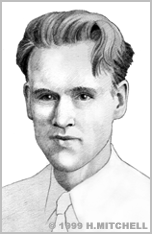Philo Farnsworth
Philo Farnsworth conceived the world's first all-electronic television at the age of 15. By the time he died, he had earned over 300 U.S. and foreign patents for electronic and mechanical devices.
Philo Taylor Farnsworth was born in 1906 in southwestern Utah in a log cabin built by his grandfather, a follower of the Mormon leader, Brigham Young. As a young boy, Farnsworth loved to read Popular Science magazine and science books. By the time he entered high school in Rigby, Idaho, he had already converted most of the family's household appliances to electrical power.
Farnsworth was particularly interested in molecular theory and motors, as well as then novel devices like the Bell telephone, the Edison gramophone, and later, the Nipkow-disc television. In 1922, Farnsworth sketched out for his chemistry teacher his idea for an "image dissector" vacuum tube that could revolutionize television.
Neither Farnsworth's teacher nor anyone else around him had ever heard of the "television," which in the 1920s meant a device that mechanically scanned an image through a spinning disc with holes cut in it, then projected a tiny, unstable reproduction of what was being scanned on a screen. Farnsworth imagined instead a vacuum tube that could reproduce images electronically by shooting a beam of electrons, line by line, against a light-sensitive screen.
In 1922, Farnsworth entered Brigham Young University, but when his father died two years later, Farnsworth had to take a public works job in Salt Lake City to support his family. But he never abandoned his dream, and in 1926, he convinced some friends to fund his invention efforts. The next year, while working in San Francisco, Farnsworth demonstrated the first all-electronic television (1927). This helped him to secure more funding and threw him and his associates into a complicated contest to set industry firsts.
In 1930, the same year that Farnsworth was granted a patent for his all-electronic TV, his labs were visited by Vladimir Zworykin of RCA, who had invented a television that used a cathode ray tube (1928) and an all-electric camera tube (1929). This led to a patent battle that lasted over ten years, resulting in RCA's paying Farnsworth $1M for patent licenses for TV scanning, focusing, synchronizing, contrast, and controls devices.
Meanwhile, there were widespread advances in television imaging (in London in 1936, the BBC introduced the "high-definition" picture) and broadcasting (in the U.S. in 1941 with color transmissions). During World War II, despite the fact that he had invented the basics of radar, black light (for night vision), and an infrared telescope, Farnsworth's company had trouble keeping pace, and it was sold to ITT in 1949.
Farnsworth's other patented inventions include the first "cold" cathode ray tube, an air traffic control system, a baby incubator, the gastroscope, and the first (albeit primitive) electronic microscope. From the 1950s until his death, his major interest was nuclear fusion. In fact, in 1965 he patented an array of tubes, called "fusors," that produced a 30-second fusion reaction.
Farnsworth, who never enjoyed good health, died of pneumonia in 1971 before he could complete his fusion work. However, the average TV set sold that year included about 100 items originally patented by him. Today, amidst cable, satellite, digital, and HD-TV, Philo Farnsworth's reputation as one of the "fathers of television" remains strong.


